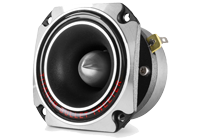Buy Speaker Components
There is a huge range of designs and brands on the market to suit your specific needs, take your time when shopping to ensure you get a compatible size for your speaker. Most speaker components can be easily swapped out using similar or upgraded units, which means you don't have to completely replace a whole system just because of a damaged driver.
Upgrading cheaper systems with better quality woofer and tweeter units can give them a new lease of life for much less cost than buying new equipment. Passive and active crossover units are available for both internal and external use, be it as replacements in a system, or as a new feature you are including as an upgrade. Power handling is also a factor, as both have far more flexible loading capabilities compared to a dome type which is restricted by the dimensions and material construct of its driver.
Speaker Parts
Most larger PA speakers these days are 3 way or full range, and there are PA Friendly speaker parts within this category. Configuring the woofers, tweeters and horns accurately will grant you the optimum frequency handling capability. Doing so lends itself to all musical styles as listeners enjoy this enhanced, balanced sound.
Loudspeaker Components
The main loudspeaker component is the woofer driver, on live PA speakers this will often be a large, 12 to 15-inch diameter to produce the larger SPL and low frequencies that are required of a party or professional environment, the more air mass speaker parts can shift, the louder and more defined the sound will be. A midrange driver can also be introduced, these will often be 2 to 4 inches diameter and are much more delicate than the woofer as they simply won't be required to deal with the larger electrical current or movement that the bass notes require. They will fill in everything from soft drum lines to a large part of the vocal spectrum, so play a hugely important role in the overall sound of a system, especially a larger live usage PA.
Topping things off is the tweeter, which is specifically designed to reproduce the high-frequency parts of the incoming signal. It does so using the same electromechanical principles as the other drivers, though depending on the actual type and design of tweeter, how it deals with the conversion can be done in several ways. Though there are at least 8 proven commercial tweeter designs, most PA and live equipment will be found to use either the piezo type or the larger horn type. The main reason for this is the dispersion characteristics, as both have a much wider throw range than a conventional hi-fi style dome tweeter.
Frequently Asked Questions
What are speaker components?
Speaker components include the driver, which converts electrical signals into sound waves; the cone, which amplifies these sound waves; the surround, allowing the cone to move while maintaining its shape and the crossover, which directs specific frequencies to appropriate drivers in multi-driver speakers.
Is a speaker driver a component?
Yes, a speaker driver is a component. It's the element within a speaker that converts electrical energy into sound waves through the movement of a diaphragm. Drivers come in various types, including woofers, tweeters, and mid-range drivers, each designed to handle different parts of the sound spectrum.
What is the difference between a speaker horn and a tweeter?
A tweeter is a speaker driver focused on high-frequency sounds (2,000-20,000 Hz), while a speaker horn is an acoustic amplifier used to enhance the efficiency and directional control of sound. Tweeters reproduce vocals, cymbals, and high-pitched instruments accurately. Horns aid in amplifying and directing sound from drivers like tweeters, especially in large spaces or outdoor environments, ensuring clearer projection.
Are all speaker drivers the same?
No, all speaker drivers are not the same. They vary significantly in design, size, and material, each tailored to reproduce different parts of the audio spectrum with accuracy. There are several types, including woofers for low frequencies (bass), tweeters for high frequencies (treble), and mid-range drivers for the frequencies in between. Subwoofers are designed specifically for very low bass frequencies.
What types of speaker components are there?
Speaker components include woofers for low frequencies, tweeters for highs, and mid-range drivers for vocals and instruments. Subwoofers target deep bass, while crossovers distribute frequencies to the right component. Each part plays a role in delivering a full audio experience, from deep bass to crystal-clear highs.
Do different speakers have different components?
Different speakers vary in components due to their design and audio goals. Basic speakers might use a single driver for all frequencies. Hi-Fi speakers incorporate woofers for lows, tweeters for highs, and mid-range drivers, with crossovers for frequency management. Subwoofers are dedicated to low frequencies, featuring a large woofer.
Why do speakers have different components?
Speakers have different components to accurately reproduce the full range of audio frequencies humans can hear, from deep bass to high treble. Each component is specialised to handle a specific portion of the sound spectrum: woofers for low frequencies, tweeters for high frequencies, and mid-range drivers for everything in between. Crossovers are used to direct the right frequencies to each specific driver, ensuring clarity and detail in the sound.
Do I need to buy separate speaker components?
No, you don't necessarily need to buy separate speaker components unless you're aiming for a custom audio setup, an upgrade to an existing system, or need to replace a specific part. Most consumers opt for pre-assembled speaker systems that come with all necessary components integrated for convenience and balanced sound. However, if you have specific audio quality goals or enjoy DIY projects, purchasing and assembling separate components allows for customisation to your preferences.
- 9
- 1
- 8
- 1
- 10
- 3
- 1
- 6



